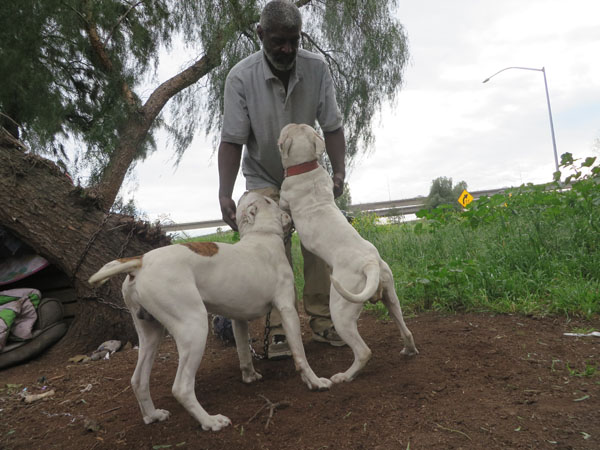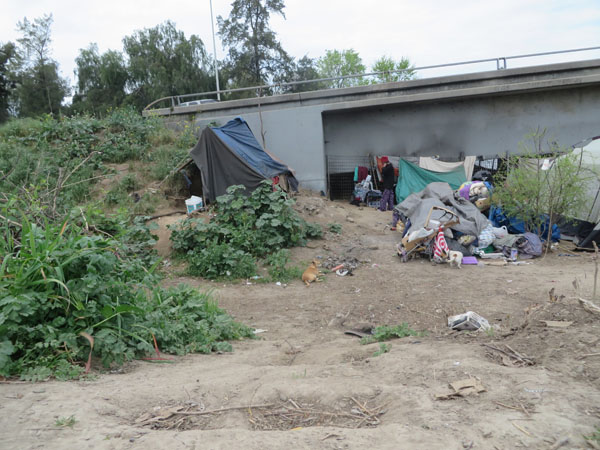
[fourcol_three][/fourcol_three] [fourcol_one_last]
Underneath Interstate 5 near downtown Stockton, a homeless population creates a community in an attempt to find refuge, safety and comfort. Their stories are all different. Their lives not much different than ours.
But the property they’ve staked doesn’t belong to them. And the homes they build can’t stay forever.
[/fourcol_one_last]
By Killian Barnhart and Mikael Honzell
There’s a stereotype of homeless individuals, one where a vice consumed their lives and forced them to the street.
Life’s misfortunes, though, can hit with the weight of a train. Such is the case for many living on the streets of Stockton. Beneath the underpass on Interstate 5, near Weber Avenue, there are individuals who’ve been hit with the worst and wound up in situations beyond their control.
Henry E. Cross Jr., a Stockton-born Marine veteran, has experienced a great deal of life’s trials that add to the narrative of his homelessness.
Patricia Henderson ended up in Stockton after living in New Jersey. Medical bills became too much. She ended up on the street.
These are two of the many who live beneath the constant whir of the highway, only to be disrupted by regular clean out notices.
The California Department of Transportation, also known as Caltrans, owns the land. The homeless technically have no right to occupy the space.
“There’s a lot of different hazards that comes with these homeless camps, unfortunately. And our number one goal is safety,” said Skip Allum, Public Information Officer for CalTrans District 10.
For those with nowhere to call home, the tension and stress makes living on the streets that much harder.
“They don’t want us to be comfortable,” Cross said. “They act like we want to be out here.”
NO CHOICE BUT THE STREETS
In 2015, Cross said he went to Las Vegas to help his daughter get out of a bad relationship and offered to babysit his grandchildren while she went to school.
There Cross met and gradually fell in love with his daughters neighbor. Over time, his girlfriend fell ill and was hospitalized.
After bringing his grandchildren to Stockton to see their grandmother, Cross returned to Las Vegas to be there for his girlfriend. A day before the girlfriend’s release, Cross was struck by a vehicle.
He was now the one in the hospital. He woke with a fractured tibia, a shattered knee in need of reassembly, nine screws and a plate inserted into him after the incident.
Cross was released a day before Christmas and was sent to receive physical therapy to gain control over his crippled leg.
“They sent me to therapy and I was really working hard, and I was supposed to be there for a month. I was only there for little over a week, I was doing my therapy because I did not want to miss New Years… Christmas was already a wash,” Cross said.
Cross was able to make it out of physical therapy a little after a week and was able to spend New Year’s with his girlfriend. However, on Jan. 2015, Cross’ girlfriend died due to complications with her health.
He had no other option but to gather his belongings and move back to Stockton.
Cross returned to Stockton and lived with a friend from high school.
This arrangement didn’t last long. The roommates were evicted. Cross had no choice but to live on the streets.
After living on the streets for a while, Cross eventually found refuge in the camp under the I-5 bridge.
STRUGGLE FOR SPACE
The dwellers under the I-5 bridge do what they can to keep the area trash free; they separate trash from personal belongings and place the trash in piles for Caltrans to pick up when they clear the camp.
However, there has been an ongoing tension between homeless campers and the transportation agency, particularly over personal belongings being thrown away rather than trash.
“Instead of coming out and cleaning the trail,” Henderson said. “They came to where we had our things packed up and literally tossed away personal items.”
Some of these items can be anything from photos, medication tents and more. Caltrans typically visits some camps to clean up at least once a month.
Cal-Trans District 10 public information officer Allum said when a camp is spotted, Caltrans will leave a posting in the camp informing its residents that they have 72 hours to gather belongings and leave the area before clean up.
“Cal-Trans folks and CHP folks go to throw away trash. If there’s things that are deemed to be of value, personal items that usually comes down to things like medicine, wallets or things like that,” he said.
Allum said when personal items are found, Cal-Trans attempts to get in to contact with the owners of the items, but can’t always find them.
“It can be a stressful situation for those that are out there,” Allum said. “And we’re mindful of that, we try to be respectful but at the same time, it’s our responsibility to maintain a safe roadway.”
Some homeless camps can cause safety hazards such as trash being blown into the roads or fire hazards caused by cooking.
BACK AND FORTH
Patricia Henderson is a New Jersey native who lived in Maryland most of her life.
She came to Stockton 14 years ago after her husband died of nasopharynx cancer.
Henderson also calls the camp under the I-5 bridge home now because she was left with no other option but to give up living in her apartment due to having to pay for expensive medical bills for an unexpected operation.
Alongside Henderson, Tim Hill, her significant other and a Stockton native who also calls the camp home, has been evicted from the area under the freeway.
“CalTrans stay on us all the time. They throw our stuff away, we have footage of them throwing our stuff away. 209Cares went down there and they (Caltrans) lied right on camera ‘we save their stuff’… as they were saying that all of it was going into a garbage truck,” said Tim Hill.
According to Henderson and Hill, the things that get thrown away vary from medication to pictures of loved ones, tents and other personal items.
“Instead of coming out and cleaning the trail, they went out to where we had our things packed up and literally just tossed away personal items,” Henderson said. “They didn’t even pick up the little bits of trash, little bits of paper on the side of the road. Just personal items.”
JOY IN COMPANIONSHIP
Over the course of living in the streets of Stockton, Cross found what would be a loyal canine companion.
“I rescued her from out here because the guy that had her had tied her up to an old tree stump for four days,” Cross said. “The third day I gave her water, the fourth day the owner still didn’t show up so I unchained her and I brought her back to the camp.”
The dog proved to be an asset to Cross’ security when she had protected him during a confrontation with masked thugs attempting to rob him, he said.
A month later the dog had a litter of 10 puppies of which Cross kept only one; a male named Spaceship, named after the nearly perfect circle fur pattern on his back.
Along with his dogs, Cross acquired other necessities he would need: Social Security, tools for constructing a home for himself and his dogs.
While life was not great, Cross did what he could to make the best of it.
He had a camp with a tarp tent, a nice reclining chair, a bed for himself to sleep in and his tools which included a couple of saws and a hatchet.
Despite Cross’s efforts to make the best of things, he ran into trouble as the Stockton Police Department asked him to remove himself from the location. He did so, along with his camp mates and went across the street near the WorkNet offices.
However, after clearing out of the area and having to place all his belongings across the street, he had grown fatigued and went to sleep only to awaken to a bulldozer clearing what Cross calls the campers belongings.
HOPE FOR THE FUTURE
Despite having been seemingly left behind by the world, the camp under I-5 has every intention of attempting to get out of their circumstances.
“There are a lot of people out here who do got skills,” said Tim. “A talented workforce, if given the chance,” added Patricia.
“I was interested in possibly starting a temporary service for felons and homeless felons out here for on the job training,” said Patricia. “I’ve been a legal secretary since I graduated from high school and because of that hands on training I have more skills and abilities than most paralegals coming out college… because ‘hands on’ there’s no better teacher.”
The plan included having the city hire the homeless with the money set aside to beautify the downtown businesses.
“While doing that, they (the homeless) would be given referral for work, of course payed daily like manpower did, that way there’s no problems as far as I.D.” said Henderson. “Our guarantee was that one: they would show up to work, and two: be sober while they work and three: be able to network themselves.”
THE HOMELESS AND THE SHELTER
Often, the campers bring up hearing the age old line of “go to the shelter,” referring to St. Mary’s Dining Room and the adjoining housing shelters. However, more often than not the homeless prefer to stay amongst their camps for various reasons.
“We can’t go to the shelter. It’s not because there’s something wrong with their rules, it’s just that they have rules that are more of a hindrance than help.” Said Cross. Cross went on to say that because of the ‘no relationships’ rule that a friend’s daughter, along with himself were removed from the shelter after he had married with consulting them.
Dogs are a staple for the camps, often acting as emotional support as well as a form of security.
The campers however, are not allowed to bring their pets into the shelter.
“We got our dogs,” Hill said, “a lot of people rely on their dogs. They’ve got service dogs that help them and they can’t take them in the shelter, unless their locked up in a kennel.” With the shelters limitations in place, many homeless individuals live on their own, with others campers or a loyal K-9 companion.





















